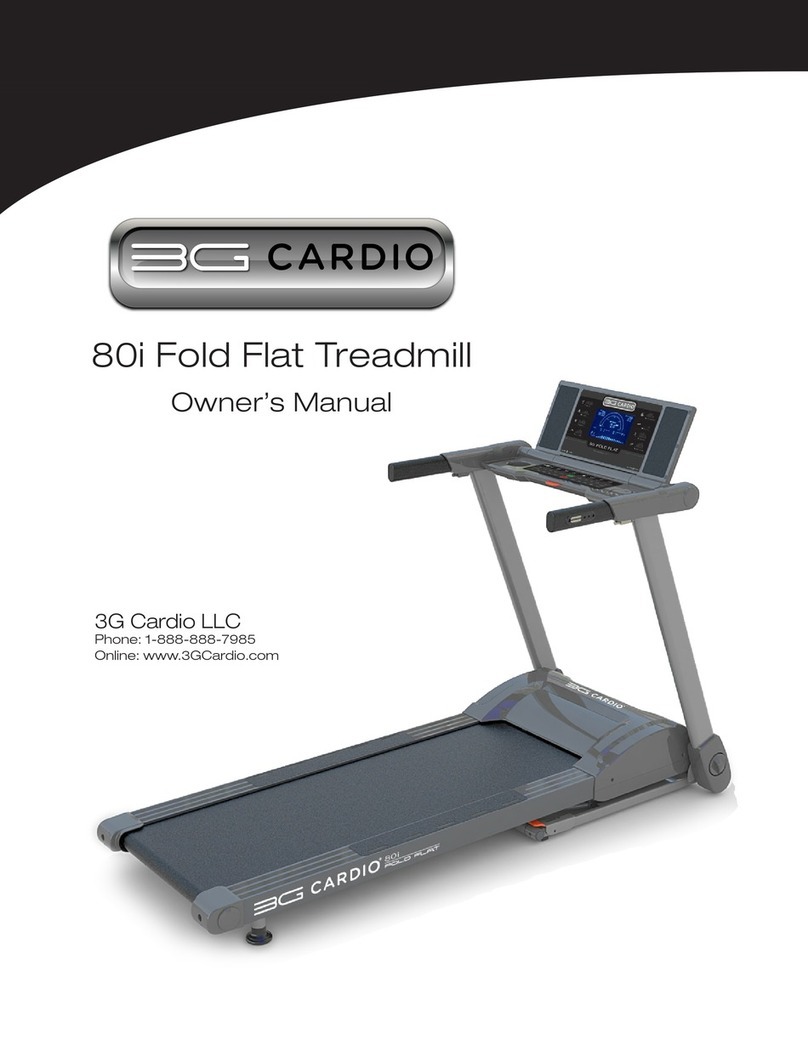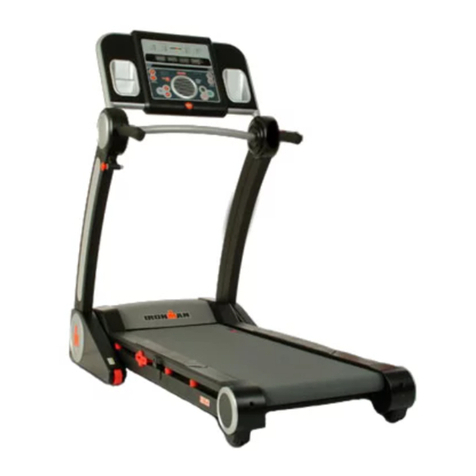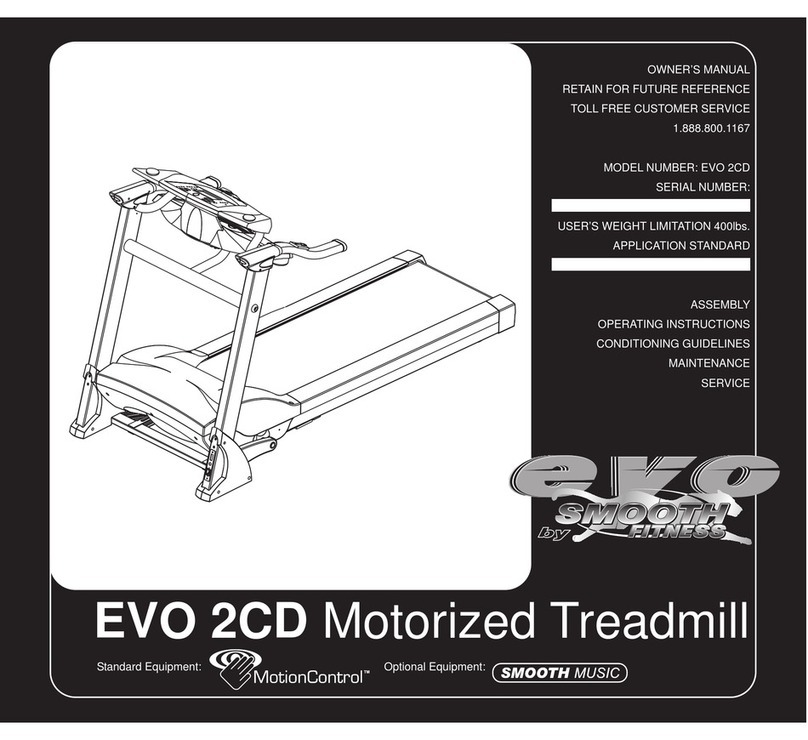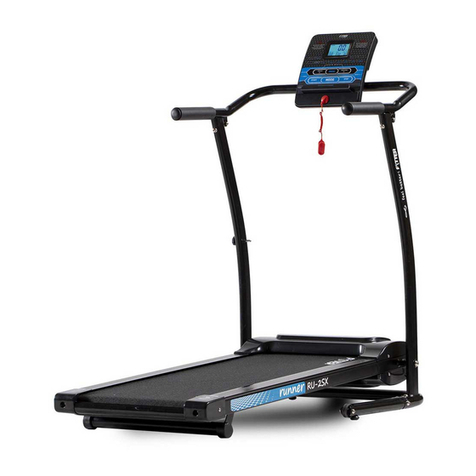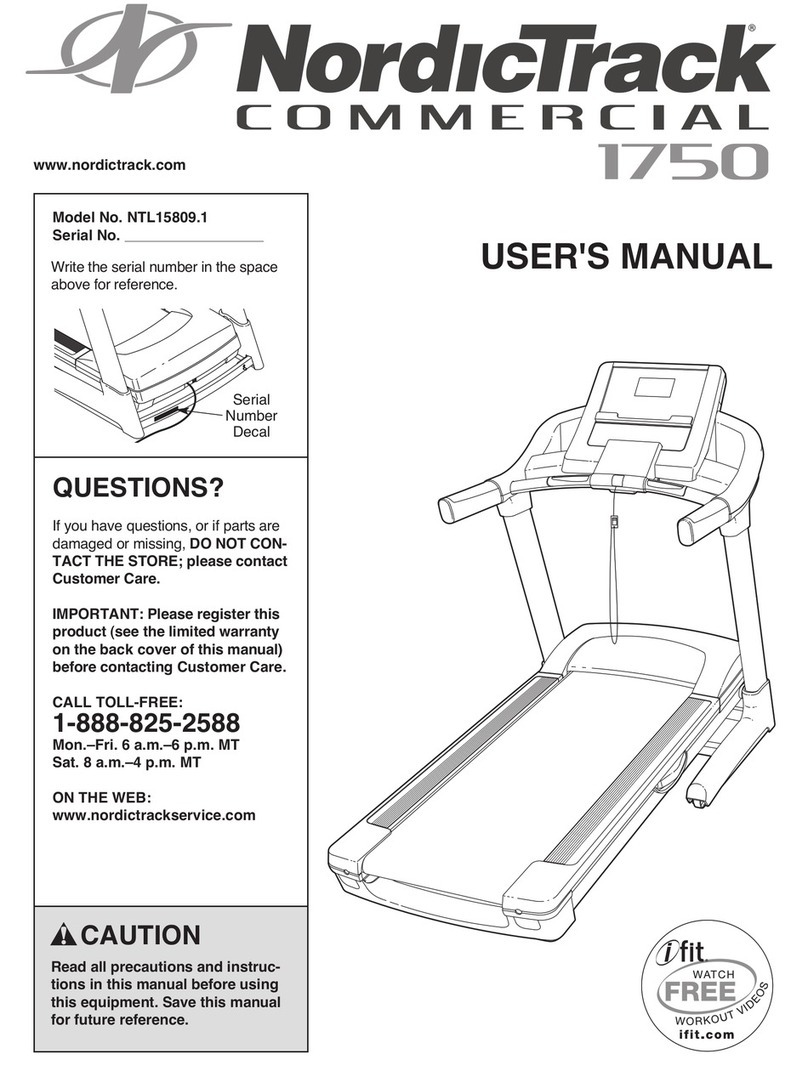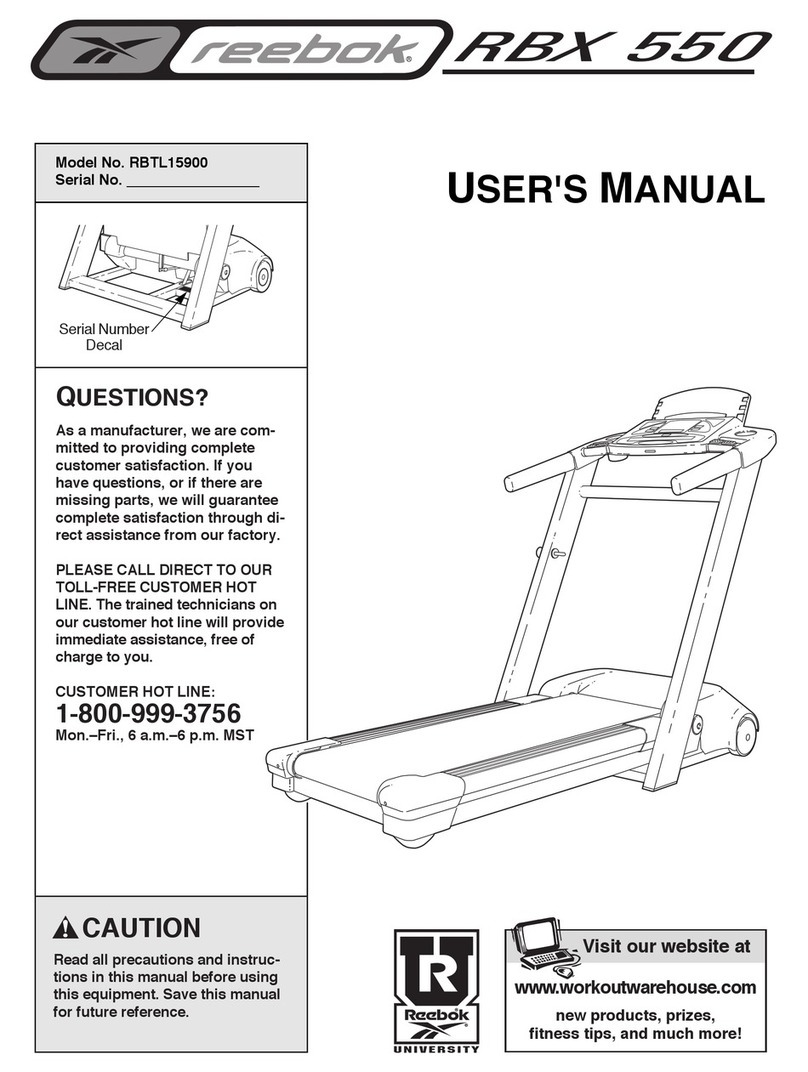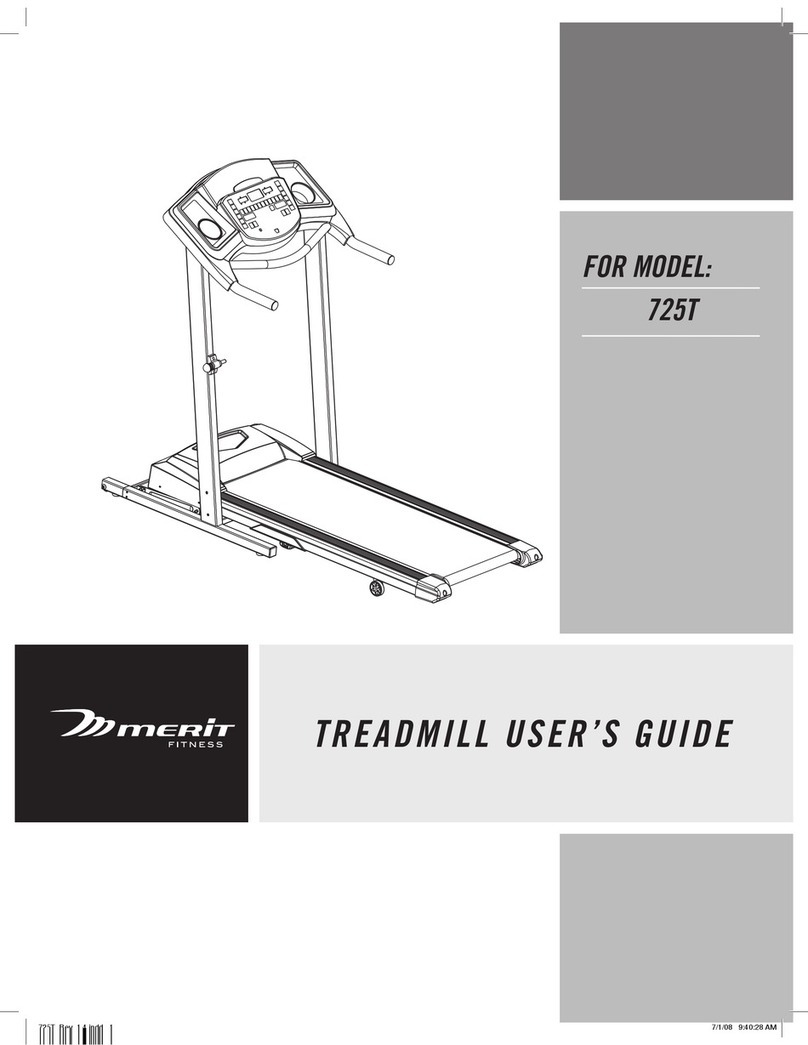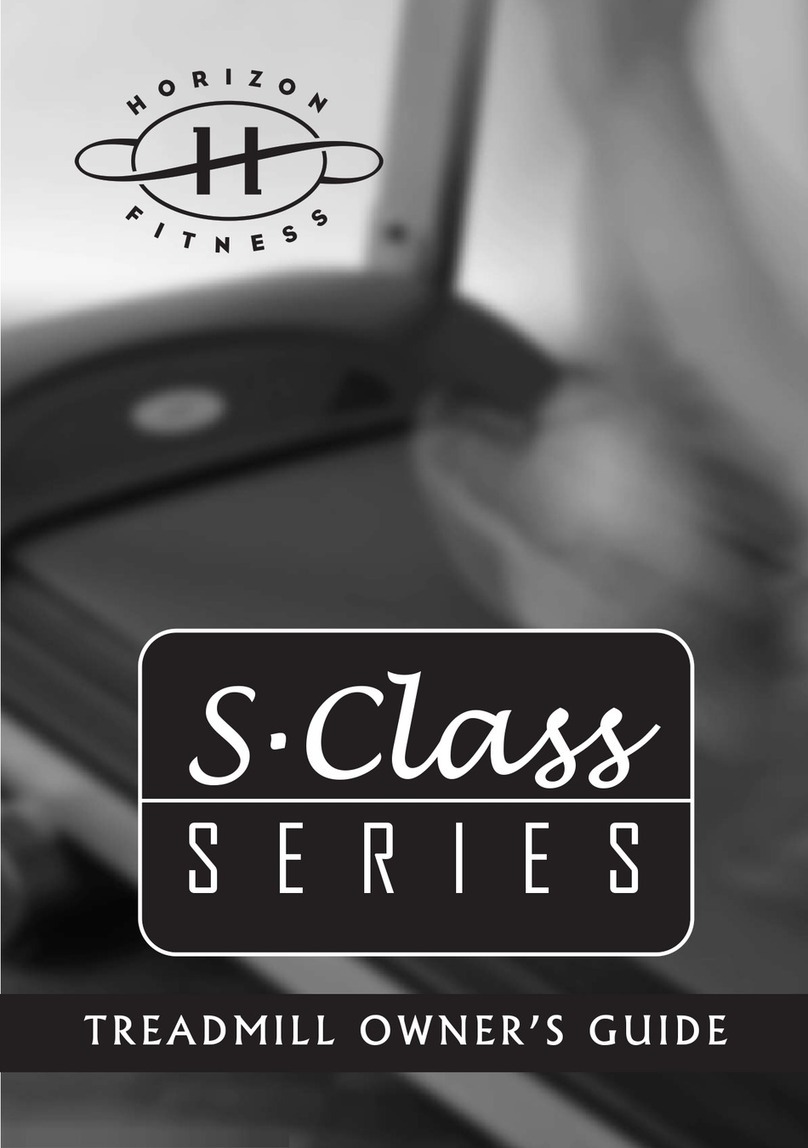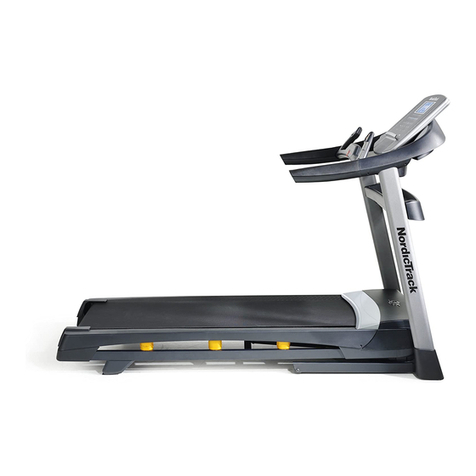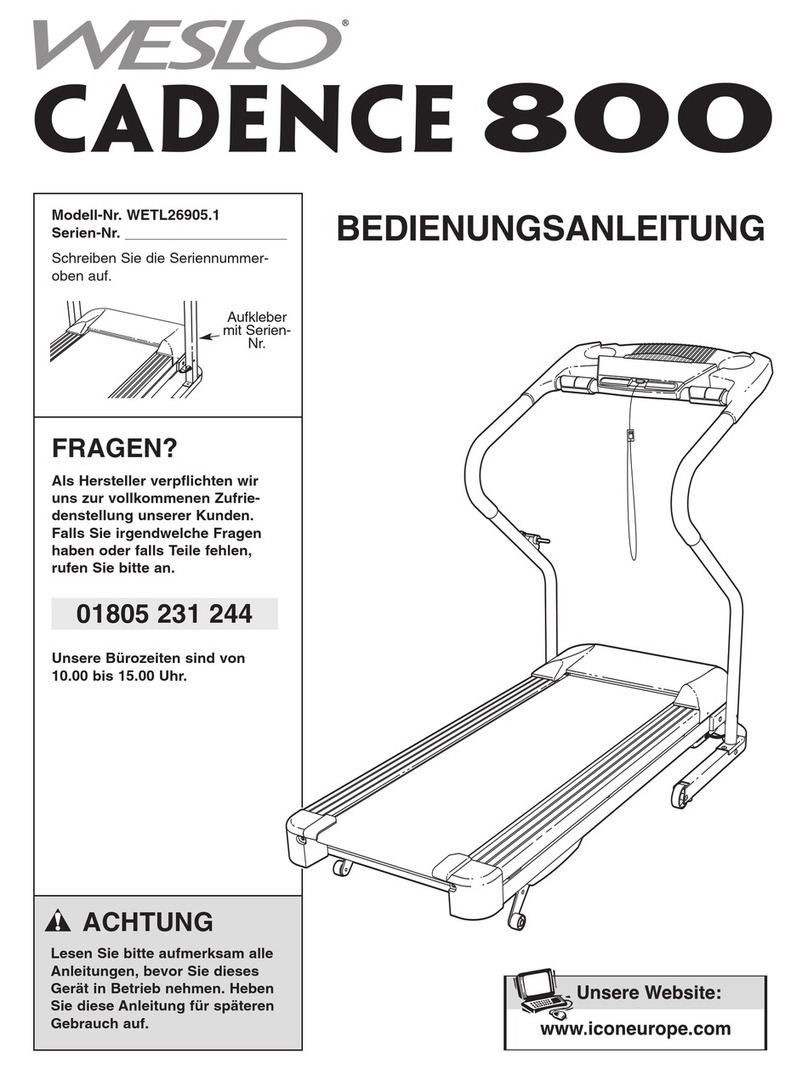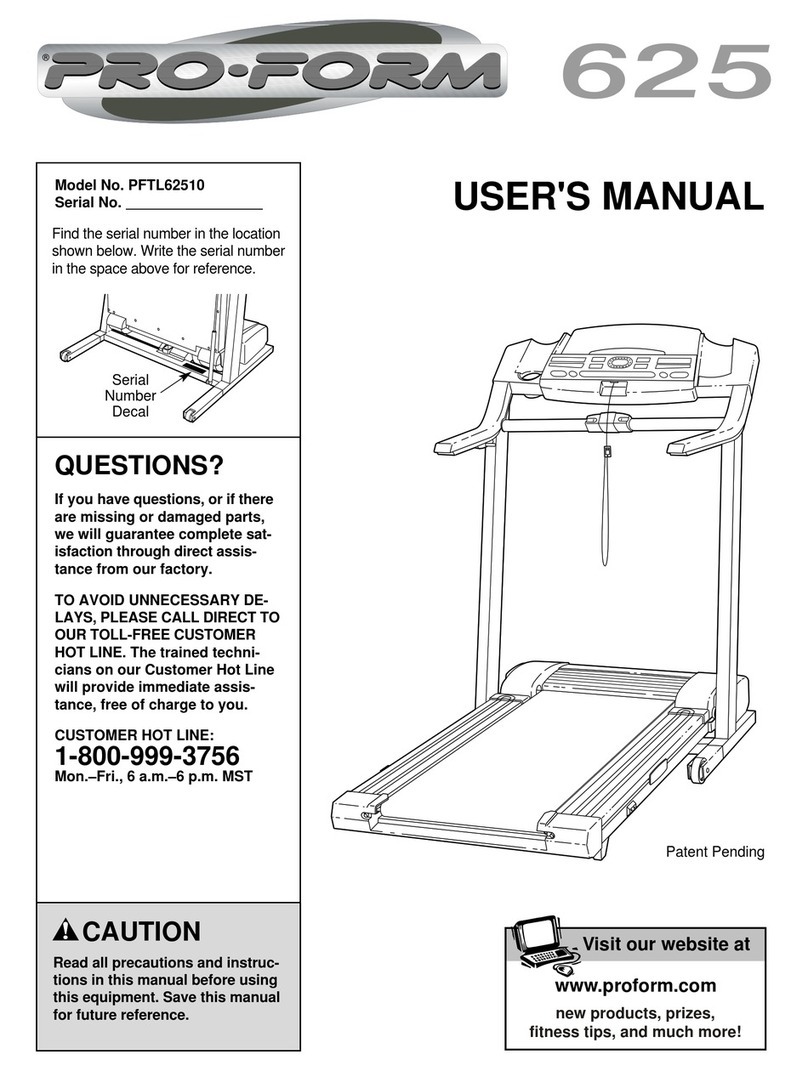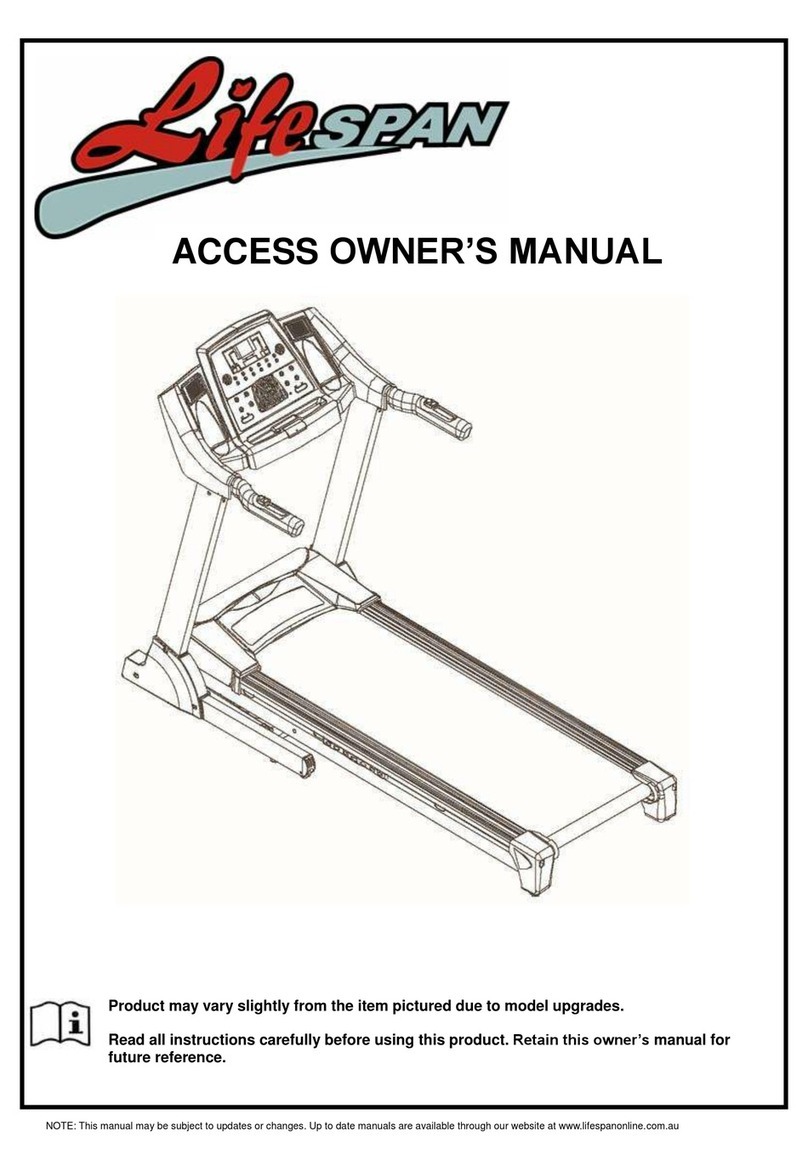BG CARDIO LITE RUNNER User manual

CARDIO
3G
®
3G
CARDIO
®
Lite Runner Treadmill
Owner’s Manual

Questions? Call 888-888-7985

www.3GCardio.com
CAR DIO
3G
®
3G
CARDIO
®
© Copyright 3G Cardio LLC
All Rights Reserved
IMPORTANT! PLEASE READ:
CARDIO
3G
®
3G
CARDIO
®
3G Cardio Fitness Equipment
14647 So. 50th Street Suite 110
Phoenix, AZ 85044
1-888-888-7985
www.3GCardio.com
support@3gcardio.com
If you purchased your 3G Cardio product from an online retailer (3GCardio.com, Amazon,
Costco etc..) and need help or have questions, comments or concerns, please call or email us
(3G Cardio) directly. We are not operators, we are experienced tness professionals and can
help you with anything and everything!
If you purchased your 3G Cardio product from a “brick and mortar” retail store, feel free
to contact the store directly with any questions or concerns. You are still more than welcome to
contact us too!

Questions? Call 888-888-7985

www.3GCardio.com
CAR DIO
3G
®
3G
CARDIO
®
TABLE OF CONTENTS
SAFETY 1 – 2
WARM UP & COOL DOWN 3
UNPACKING & ASSEMBLY 4 – 6
COMPUTER OPERATIONS 7 – 8
BELT A DJ USTMENT 9 – 10
LUBRICATION MAINTENANCE 11 – 12
TROUBLESHOOTING 13
PARTS LIST 14
PARTS LIST - BOLTS 15
EXPLODED DRAWING 16
WARRANTY 17

1Questions? Call 888-888-7985
IMPORTANT: Read all instructions and warnings before using the treadmill
IMPORTANT VOLTAGE INFORMATION !
Before plugging the power cord into an electrical outlet, verify that the voltage requirements for your
area match the voltage of the treadmill that you have received,. The power requirements for this
treadmill include a grounded, dedicated circuit, rated for one of the following: 115VAC +- 5%, 60Hz and
20amps; 208/220 VAC, 60Hz, 15amps or 230 VAC +- 5%, 50Hz and 10amps. Check with your dealer for
the exact voltage requirements of your treadmill. Use of wrong voltage will damage the treadmill.
WARNING! : Do not attempt to use this treadmill with a voltage adapter.
Do not attempt to use this treadmill with an extension cord.
GROUNDING INSTRUCTIONS
This treadmill must be grounded. If it should malfunction or break down, grounding provides a path of
least resistance for electric current to reduce the risk of electric shock. This product is equipped with a
cord having an equipment-grounding conductor and a grounding plug. The plug must be plugged into an
appropriate outlet that is properly installed and grounded in accordance with all local codes and
ordinances.
DANGER!
Improper connection of the equipment-grounding conductor can result in a risk of electric shock.
Check with a qualified electrician or service provider if you are in doubt as to whether the
treadmill is properly grounded.
SAFETY
CONSULT A PHYSICIAN IMMEDIATELY
Warning: before starting any exercise program consult your physician. This is especially
important for individuals over the age of 35 or persons with pre-existing health problems. Read
all instructions before using any fitness equipment. We assume no responsibility for personal
injury damage sustained by or through the use of this treadmill.
1
– Obtain a medical exam before beginning any exercise program.
– Keep children and pets away from the treadmill. Teenagers and disabled persons must be
supervised while using the treadmill.
– Stop exercising if you feel faint, dizzy, or experience pain at any time while exercising and consult
your physician.
– Clip the SAFETY KEY onto your clothing and carefully test it prior to using the treadmill.
– Disconnect all power before servicing the treadmill.
– Connect the treadmill to a properly grounded outlet only.
– Do not operate electrically powered treadmill in damp or wet locations.
– Remove the SAFETY KEY when not in use.
– Inspect the treadmill for worn or loose components before each use.
– Do not operate the treadmill if 1. The power cord is damaged; 2. the treadmill is not working
properly; 3. The treadmill has been dropped or damaged.
– Do not use the treadmill outdoors.
– Read and understand this owner's manual completely before using the treadmill.
– Read and understand all warnings posted on the treadmill and in this owner's manual.
– Do not wear loose or dangling clothing while using the treadmill.
– Always wear proper footwear on or around exercise equipment.
– Set up and operate the treadmill on a solid, level surface. Do not operate in recessed areas or on
plush carpet.
– Provide the following clearances: 75cm at each side, 100cm at the back and enough room for safe
access and passage at the front of the treadmill.
– Do not modify the treadmill in any way.
IMPORTANT SAFETY INSTRUCTIONS
SAFETY
IMPORTANT: Read all instructions and warnings before using treadmill.
IMPORTANT VOLTAGE INFORMATION!
Before plugging the power cord into an electrical outlet, verify that the voltage requirements for your area match
the voltage of the treadmill that you have received. The power requirements for this treadmill include a grounded,
dedicated circuit, rated for one of the following: 115VAC +- 5%, 60Hz and 20amps; 208/220 VAC, 60Hz, 15amps or
230 VAC +- 5%, 50Hz and 10amps. Use of wrong voltage will damage the treadmill.
GROUNDING INSTRUCTIONS:
This treadmill must be grounded. If it should malfunction or break down, grounding provides a path of least resistance
for electric current to reduce the risk of electric shock. This treadmill has a power cord which has a grounding
conductor and grounding plug. The plug must be plugged into an appropriate outlet that is properly installed and
grounded in accordance with all local codes and ordinances.
DANGER!
Improper connection of the equipment-grounding conductor can result in a risk of electric shock. Check with a
qualied electrician or service provider if you are in doubt as to whether the treadmill is properly grounded.
CONSULT A PHYSICIAN IMMEDIATELY!
Warning: Before starting any exercise program consult your physician. This is especially important for individuals
over the age of 35 or persons with pre-existing health problems. Read all instructions before using any tness
equipment. 3G Cardio LLC assumes no responsibility for personal injury or damage sustained by or through the use
of this treadmill.
IMPORTANT SAFETY INSTRUCTIONS:
• Obtain a medical exam before beginning any exercise program.
• Keep children and pets away from the treadmill. Teenagers and disabled persons must be supervised while using
the treadmill.
• Stop exercising if you feel faint, dizzy, or experience pain at any time while exercising and consult your physician.
• Clip the SAFETY KEY onto your clothing and carefully test it prior to using the treadmill.
• Disconnect all power before servicing the treadmill.
• Connect the treadmill to a properly grounded outlet only.
• Do not operate treadmill in damp or wet locations.
• Disengage the SAFETY KEY when not in use.
• Inspect the treadmill for worn or loose components before each use.
• Do not operate the treadmill if:
1) The power cord is damaged.
2) The treadmill is not working properly.
3) The treadmill has been dropped or damaged.
• Do not use the treadmill outdoors.
• Read and understand this owner’s manual completely before using the treadmill.
• Read and understand all warnings posted on the treadmill and in this owner’s manual.
• Do not wear loose or dangling clothing while using the treadmill.
• Always wear proper footwear on or around exercise equipment.
• Set up and operate the treadmill on a solid, level surface.
• Provide the following clearances: 1 foot clearance on right and left side, 5 feet of clearance behind the running belt
and enough room for safe access at the front of the treadmill.
• Modifying this treadmill in any way will void all warranties.

2
www.3GCardio.com
CAR DIO
3G
®
3G
CARDIO
®
2
SAFETY
Target Heart Rate Zone
220-your age =maximum heart zone
You do not want to workout at your maximum heart rate. The
recommended Heart Rate Zone is a percentage of your
maximum heart rate. Between 60% and 75% of your
maximum heart rate.
Lower limit of Target Heart Rate Zone =maximum heart rate
X 0.6
Upper limit of Target Heart Rate Zone
=Maximum heart rate X0.75
(This is recommended by American Heart Association.
Before starting exercise program, please consult your
TARGET HEART RATE ZONE
HOW OFTEN SHOULD YOU EXERCISE:
You should exercise three to four times a week to improve your cardiovascular and muscle
fitness.
HOW HARD SHOULD YOU EXERCISE:
Intensity of exercise is reflected in your heart rate. Exercise must be sufficiently rigorous to
strengthen your heart muscle and condition your cardiovascular system. Only your doctor
can prescribe the target training heart range for you. Before starting any exercise program
consult your physician.
HOW LONG SHOULD YOU EXERCISE:
Sustained exercise conditions your heart, lungs and muscles. The longer you are able to
sustain exercise within your target heart range, the greater the aerobic benefits. To begin
maintain 2~3 minutes of steady, rhythmic exercise, then check your heart rate.
You do not want to workout at your maximum heart rate. The
recommended Heart Rate Zone is a percentage of your maximum
heart rate. Between 60% and 75% of your maximum heart rate.
Lower limit of Target Heart Rate Zone = Maximum heart rate X 0.6
Upper limit of Target Heart Rate Zone = Maximum heart rate X 0.75
HOW OFTEN SHOULD YOU EXERCISE?
You should exercise three to four times a week, 30 minutes per
workout, or as instructed by your doctor.
HOW HARD SHOULD YOU EXERCISE?
Intensity of exercise is reected in your heart rate. Exercise must
be sufciently rigorous to strengthen your heart muscle and
condition your cardiovascular system. Before starting any exercise program consult your physician.
HOW LONG SHOULD YOU EXERCISE?
Sustained exercise conditions your heart, lungs and muscles. The longer you are able to sustain exercise within your
target heart range, the greater the aerobic benets. You should always begin a workout with at least a 5 minute warm
up at low intensity.
2
SAFETY
Target Heart Rate Zone
220-your age =maximum heart zone
You do not want to workout at your maximum heart rate. The
recommended Heart Rate Zone is a percentage of your
maximum heart rate. Between 60% and 75% of your
maximum heart rate.
Lower limit of Target Heart Rate Zone =maximum heart rate
X 0.6
Upper limit of Target Heart Rate Zone
=Maximum heart rate X0.75
(This is recommended by American Heart Association.
Before starting exercise program, please consult your
TARGET HEART RATE ZONE
HOW OFTEN SHOULD YOU EXERCISE:
You should exercise three to four times a week to improve your cardiovascular and muscle
fitness.
HOW HARD SHOULD YOU EXERCISE:
Intensity of exercise is reflected in your heart rate. Exercise must be sufficiently rigorous to
strengthen your heart muscle and condition your cardiovascular system. Only your doctor
can prescribe the target training heart range for you. Before starting any exercise program
consult your physician.
HOW LONG SHOULD YOU EXERCISE:
Sustained exercise conditions your heart, lungs and muscles. The longer you are able to
sustain exercise within your target heart range, the greater the aerobic benefits. To begin
maintain 2~3 minutes of steady, rhythmic exercise, then check your heart rate.
3 minutes at moderate, then 3 minutes at higher exertion,
then 3 minutes at easy. Continue this pattern for 24
minutes.
6 – 12 Minutes
10 – 16 Minutes
14 – 20 Minutes
18 – 24 Minutes
22 – 28 Minutes
20 Minutes
TARGET HEART RATE ZONE
Target Heart Rate Zone
220 – Your Age = Maximum Heart Zone
BEGINNER TREADMILL PROGRAM
SAFETY

3Questions? Call 888-888-7985
3
WARM-UP & COOL DOWN
WARM- UP& COOL-DOWN
A successful exercise program consists of a warm up, aerobic exercise, and a cool down. Warming up is
an important part of your workout, and should begin every session. It prepares your body for more
strenuous exercise by heating up and stretching out your muscles. At the end of your workout, repeat
these exercises to reduce sore muscle problems. We suggest the following warm-up and cool-down
exercises:
Head Rolls
Rotate your head to the right for one
count, feeling the stretch up the left
side of your neck. Next rotate your
head back for one count, stretching
your chin to the ceiling and letting your
mouth open. Rotate your head to the
left for one count, and finally, drop
your head to your chest for one count.
Shoulder Lifts
Lift your right shoulder up toward
your ear for one count. Then lift
your left shoulder up for one
count as you lower your right
shoulder.
Side Stretches
Open your arms to the side and
continue lifting them until they are
over your head. Reach your right
arm as far upward toward the
ceiling as you can for one count.
Feel the stretch up your right side.
Repeat this action with your left
arm.
Quadriceps Stretch
With one hand against a wall
for balance, reach behind you
and pull your right foot up. Bring
your heel as close to your
buttocks as possible. Hold for
15 counts and repeat with left
foot up.
Inner Thigh Stretch
Sit with the soles of your feet
together with your knees
pointing outward. Pull your feet
as close into your groin as
possible. Gently push your
knees toward the floor. Hold for
15 counts.
Toe Touches
Slowly bend forward from your
waist, letting your back and
shoulder relax as you stretch
toward your toes. Reach down
as far as you can and hold for
15 seconds.
Calf / Achilles Stretch
Lean against a wall with your
left leg in front of the right and
your arms forward. Keep your
right leg straight and the left
foot on the floor; then bend the
left leg and lean forward by
moving your hips toward the
wall. Hold, then repeat on the
other side for 15 seconds.
1
2
3
4
5
6
8
7
Hamstring Stretches
Sit with your right leg straight in
front of you. Straighten your leg
out while trying to hold on to
your outstretched leg with your
hand. Starting up with your back
straight. Slowly exhale and try
to bring your chest to the knee
of your outstretched leg. Hold,
then repeat on the other side for
15 seconds.
WARM UP & COOL DOWN
WARM UP & COOL DOWN
A successful exercise program consists of a warm up, aerobic exercise, and a cool down. Warming up is an
important part of your workout, and should begin every session. It prepares your body for more strenuous
exercise by heating up and stretching out your muscles. At the end of your workout, repeat these exercises to
properly cool down. We suggest the following warm up and cool down exercises:

4
www.3GCardio.com
CAR DIO
3G
®
3G
CARDIO
®
WARNING!: Use extreme caution when assembling the treadmill. Failure to do so could result in injury.
NOTE: Each step number in the assembly instructions tells you what you will be doing. Read and
understand all instructions thoroughly before assembling the treadmill.
1. Unpack the carton and separate all parts.
2. With the carton open and parts unpacked, fold up the treadmill.
3. At the rear of the treadmill and with it in a folded position you may now move the treadmill off the packaging.
There are wheels attached to the frame. Be very careful to not tip the treadmill as it may fall and cause
property or bodily harm. Please have two adults available whenever moving the treadmill.
4. Be careful to not place your hands in a pinch point area as shown in the picture.
5. Please exercise common sense whenever moving this treadmill.
CORRECT
PINCH POINT!
DANGER!
WRONG
Ensure that the following items are present. If any of the parts are missing, contact your dealer or 3G Cardio directly.
M8X15mm hex socket head bolt 12pcs
(base frame and console)
Allen wrench
Safety key
HARDWARE KIT
Lubricant for
running deck
Main body Hardware kit
Power cord
Console Console mast Console mast cover
Protective cover
M4X10mm hex socket head bolt 4pcs
(base frame and protective cover)
UNPACKING & ASSEMBLY

5Questions? Call 888-888-7985
ASSEMBLY INSTRUCTIONS
Console
Safety key
Console mast
Quick Touch Button
Base frame
Motor cover
Running belt
Mobile wheel
Side Rail
Roller cover
Console mast cover
Protective cover

6
www.3GCardio.com
CAR DIO
3G
®
3G
CARDIO
®
ASSEMBLY INSTRUCTIONS
STEP 1- Attach the console
masts to the base frame
STEP 2- Attach the console to the
PIN
Pins are normal Pin is crooked
STEP 4- Attach the console
mast covers
STEP 5- Put the safety key on
console masts
STEP 3- Secure the bolts
STEP 6- Assemble the protective cover
to the main body
A). Assemble protective cover to the main body,
secure with M4X10mm bolts.
Wire
A). Insert the left console mast (the side without a data
cable attached inside) into the base frame. Attach the
left console mast with four M8X15mm bolts using an
Allen wrench. (Do not fully tighten the bolts yet)
A). Connect the upper console data cable to the lower
console data cable and plug into lower control
board (next to incline motor). Attach with two
M8X15 bolts on each side using an Allen wrench.
(Do not fully tighten the bolts yet)
(Caution: Be very careful when connecting the
two data cables together! There are pins inside the
connector and they must be lined up and straight.
If they are not lined up, the pins can bend and
break resulting in an E1 Error Message or
loss of power).
B). Put the lower data cable and grounded wire inside
and through the right console mast using the wire
attached inside the right console mast. Insert the
right console mast into the base frame and secure it
with four M8X15mm bolts using an Allen wrench.
(Do not fully tighten the bolts yet)

7Questions? Call 888-888-7985
COMPUTER OPERATIONS
INCLINE: Indicates incline in percent of grade in 1% increments.
CALORIES: Indicates calories burned.
PULSE: Estimated heart rate.
SPEED: Indicates MPH in 0.1 increments.
DISTANCE: Indicates MPH travelled in 0.1 increment.
TIME: Indicates Workout TIME, either "elapsed time"
or "remaining time."
START: Start the treadmill belt.
SPEED PLUS/MINUS:
• Used to adjust speed in 0.1 MPH increments.
• To set programs(P1~P10).
• Set time to countdown.
MODE: Enter programs selection, enter
time setting, toggle between TIME or DISTANCE,
PULSE or CALORIES.
STOP: Stop the treadmill belt.
UP/DOWN: Adjust incline.
CONTROL PANEL FUNCTION
QUICK START (P1 MANUAL):
1). Power on, attach SAFETY KEY.
2). Press to begin treadmill belt movement.
3). Adjust speed using SPEED .
4). Adjust incline using INCLINE .
CONTROL PANEL OPERATION
ONE-TOUCH SPEED 2, 4, 6, 8: Used to reach ideal speed.
ONE-TOUCH INCLINE 0, 2, 6, 10: Used to reach ideal incline.
PROGRAMS (P2~P10):
1). Power on, put SAFETY KEY on.
2). Press to select programs.
3). Press to enter time setting.
4). Press to set exercise time.
5). Press to start treadmill belt.
6). Adjust speed using adjust incline using .
7). Press to stop treadmill belt.

8
www.3GCardio.com
CAR DIO
3G
®
3G
CARDIO
®
COMPUTER OPERATIONS
INCLINE: INCLINE PROGRAM, incline change
SPEED: SPEED PROGRAM, speed change
15
13
9
11
3
1
5
7
Program 6: INCLINE
Program 2: SPEED Program 3: SPEED Program 4: SPEED Program 5: SPEED
1
15
5
3
7
11
9
13
Program 7: INCLINE Program 8: INCLINE Program 9: INCLINE Program 10: INCLINE
ONE-TOUCH SPEED/ONE-TOUCH INCLINE:
Speed 2 miles per hour 2
6
8
Speed 4 miles per hour
Speed 6 miles per hour
Speed 8 miles per hour
Incline level 0
2Incline level 2
6Incline level 6
10 Incline level 10
4
0
S OPT
PU
DOWN
START
F TAS
SLOW
STOP
UP
DOWN
START
FAST
SLOW
upIncline
Incline down
Speed up
downSpeed
Hand pulse
QUICK TOUCH HANDLEBAR BUTTONS
These buttons allow you to perform multiple functions during your workout while you are
holding onto the handlebars. With these buttons, you can change speed and incline and
start and stop the treadmill.
ONE-TOUCH SPEED / INCLINE is meant to provide an easy and convenient way to quickly
set your desired speed and or incline. Always consult your doctor prior to beginning an
exercise program and to determine a safe and appropriate heart rate and walking pace.
.
ONE-TOUCH INCLINE ONE-TOUCH SPEED
Use your One-Touch Incline buttons
to quickly set your ideal Incline.
Use your One-Touch Speed buttons
to quickly set your ideal Speed.

9Questions? Call 888-888-7985
BELT ADJUSTMENT:
IMPORTANT: DO NOT OVER TIGHTEN THE TREADMILL BELT! THIS WILL VOID YOUR BELT WARRANTY!
You may need to adjust the running belt during the rst few weeks of use. Over time, you will need to adjust it less frequently as the running
belt will adjust to your walking or running style. The treadmill belt may stretch or become off-center within the rst few weeks or months and
this is perfectly normal during the break-in period.
ADJUSTING THE TREADMILL BELT TENSION:
If the running belt feels as though it is “slipping” or hesitating when you plant your foot during a run, the tension on the treadmill belt may have
to be increased. Again, this is normal and easy to rectify.
A. Place a hex wrench on the LEFT side tension bolt. Turn the wrench clockwise 1/4 turn to draw the rear roller and increase the belt tension.
B. Repeat STEP A on the RIGHT belt tension bolt. You must be sure to turn both bolts the same number of turns, so the rear roller will stay
square relative to the frame.
C. After completing STEP A and STEP B, walk on the treadmill to determine if the “slip” is gone.
D. Repeat STEP A and STEP B until the slipping is eliminated.
E. Be careful not to over tighten the treadmill belt as you can create excessive pressure on the front and rear roller bearings and or tear the
running belt seam. An excessively tightened running belt will damage the roller bearings and treadmill belt.
F. If your belt is no longer “slipping” but off center, STOP and read below for how to center the treadmill belt.
TO DECREASE THE TENSION ON THE TREADMILL BELT, TURN BOTH BOLTS COUNTER- CLOCKWISE THE SAME NUMBER OF
TURNS.
IMPORTANT: If your treadmill belt is rubbing on the side frame or is very close to touching the side frame you will need to center the
treadmill belt with the treadmill off. Once you adjust the rear tension bolts properly, then turn the treadmill on to 2.0mph (no faster) and
with your foot, manually “push” the treadmill belt away from the side rail. This will safely remove the belt from the side rail and speed
up the “centering” process. Use extreme caution while the treadmill belt is moving.
CENTERING THE TREADMILL BELT
When you walk or run, you may push off harder with one foot than the other. The severity of the deection depends on the amount of force
that one foot exerts in the relation to the other. This deection can cause the treadmill belt to move off center. This deection is normal and the
treadmill belt should center on its own when the treadmill is unoccupied. If the treadmill belt remains consistently off-center, you will need to
center the treadmill belt manually (see below).
A. Observe the treadmill belt and see if it is
touching either the right or left side of the frame. If
it is, read the IMPORTANT instructions above!
B. Start the treadmill without anyone on the
treadmill belt. Press the Speed Up button until the
speed reaches 2.5 mph, or a safe walking speed
for you. Use extreme caution while the treadmill
belt is moving.
C. Observe whether the treadmill belt is closer to
the right or left side of the deck.
If you need to align the treadmill belt from the
left side to right side, always adjust the left side bolt
only. The simple rule of thumb for aligning the belt is
this: working from the (user) left side bolt, if you need
to move the belt to the right, “tighten” the left side bolt
(turn clockwise in 1/4 turns only). This will move the belt
slightly to the right.
If you need to align the belt to the left, “loosen” the
left side bolt (turn the bolt counter clockwise in 1/4
turns only). This will move the treadmill belt to the left.
Anytime you need to either tighten the belt or align the belt, you should have the treadmill running at around 2.5 mph. Also, these adjustments
can take up to 30 seconds to alter the position of the belt so be patient.
NEVER OVER TIGHTEN THE TREADMILL BELT AS IT WILL RUIN YOUR TREADMILL!
Use extreme caution while the treadmill belt is moving.
You may need to adjust the running belt during the first few weeks of use. All running belts are properly set at
the factory. It may stretch or be off-center after use. Stretching is normal during the break-in period.
ADJUSTING THE BELT TENSION
If the running belt feels as though it is "slipping" or hesitating when you plant your foot during a run, the
tension on the running belt may have to be increased.
TO INCREASE THE RUNNING BELT TENSION:
A. Place 8MM wrench on the left belt tension bolt. Turn the wrench clockwise 1/4 turn to draw the rear roller
and increase the belt tension.
B. Repeat STEP A for the right belt tension bolt. You must be sure to turn both bolts the same number of
turns, so the rear roller will stay square relative to the frame.
C. Repeat STEP A and STEP B until the slipping is eliminated.
D. Be careful not to tighten the running belt tension too much as you can create excessive pressure on the
front and rear roller bearings. An excessively tightened running belt may damage the roller bearings that
would result in bearing noise from the front and rear rollers.
TO DECREASE THE TENSION ON THE RUNNING BELT, TURN BOTH BOLTS COUNTER-
CLOCKWISE THE SAME NUMBER OF TURNS.
CENTERING THE RUNNING BELT
When you run, you may push off harder with one foot than with another. The severity of the deflection depends on
the amount of force that one foot exerts in the relation to the other. This deflection can cause the belt to move off-
center. This deflection is normal and the running belt will centre when no body is on the running belt. If the running
belt remains consistently off-center, you will need to centre the running belt manually.
A). Start the treadmill without anyone on the running belt, press (SPEED UP ) bottom until speed reached 6kph.
B). Observe whether the running belt is toward the right or left side of the deck.
a. If toward the left side of the deck
Using wrench, turn the left adjustment bolt clockwise 1/4, turn the right adjustment bolt counterclockwise
1/4.
b. If toward the right side of the deck
Using wrench, turn the right adjustment bolt clockwise 1/4, turn the left adjustment bolt counterclockwise
1/4.
c. If the belt is still not centered, repeats the above steps until the running belt is on center.
C). After the belt is centered, increase the speed to 16kph and verify that it is running smoothly. Repeat the
above steps if it is necessary.
or
or
BELT ADJUSTMENT
16
BELT ADJUSTMENT
Front Roller
LEFT
RIGHT
LEFT
RIGHT
You may need to adjust the running belt during the first few weeks of use. All running belts are properly set at
the factory. It may stretch or be off-center after use. Stretching is normal during the break-in period.
ADJUSTING THE BELT TENSION
If the running belt feels as though it is "slipping" or hesitating when you plant your foot during a run, the
tension on the running belt may have to be increased.
TO INCREASE THE RUNNING BELT TENSION:
A. Place 8MM wrench on the left belt tension bolt. Turn the wrench clockwise 1/4 turn to draw the rear roller
and increase the belt tension.
B. Repeat STEP A for the right belt tension bolt. You must be sure to turn both bolts the same number of
turns, so the rear roller will stay square relative to the frame.
C. Repeat STEP A and STEP B until the slipping is eliminated.
D. Be careful not to tighten the running belt tension too much as you can create excessive pressure on the
front and rear roller bearings. An excessively tightened running belt may damage the roller bearings that
would result in bearing noise from the front and rear rollers.
TO DECREASE THE TENSION ON THE RUNNING BELT, TURN BOTH BOLTS COUNTER-
CLOCKWISE THE SAME NUMBER OF TURNS.
CENTERING THE RUNNING BELT
When you run, you may push off harder with one foot than with another. The severity of the deflection depends on
the amount of force that one foot exerts in the relation to the other. This deflection can cause the belt to move off-
center. This deflection is normal and the running belt will centre when no body is on the running belt. If the running
belt remains consistently off-center, you will need to centre the running belt manually.
A). Start the treadmill without anyone on the running belt, press (SPEED UP ) bottom until speed reached 6kph.
B). Observe whether the running belt is toward the right or left side of the deck.
a. If toward the left side of the deck
Using wrench, turn the left adjustment bolt clockwise 1/4, turn the right adjustment bolt counterclockwise
1/4.
b. If toward the right side of the deck
Using wrench, turn the right adjustment bolt clockwise 1/4, turn the left adjustment bolt counterclockwise
1/4.
c. If the belt is still not centered, repeats the above steps until the running belt is on center.
C). After the belt is centered, increase the speed to 16kph and verify that it is running smoothly. Repeat the
above steps if it is necessary.
or
or
BELT ADJUSTMENT
16
BELT ADJUSTMENT
Front Roller
LEFT
RIGHT
LEFT
RIGHT
You may need to adjust the running belt during the first few weeks of use. All running belts are properly set at
the factory. It may stretch or be off-center after use. Stretching is normal during the break-in period.
ADJUSTING THE BELT TENSION
If the running belt feels as though it is "slipping" or hesitating when you plant your foot during a run, the
tension on the running belt may have to be increased.
TO INCREASE THE RUNNING BELT TENSION:
A. Place 8MM wrench on the left belt tension bolt. Turn the wrench clockwise 1/4 turn to draw the rear roller
and increase the belt tension.
B. Repeat STEP A for the right belt tension bolt. You must be sure to turn both bolts the same number of
turns, so the rear roller will stay square relative to the frame.
C. Repeat STEP A and STEP B until the slipping is eliminated.
D. Be careful not to tighten the running belt tension too much as you can create excessive pressure on the
front and rear roller bearings. An excessively tightened running belt may damage the roller bearings that
would result in bearing noise from the front and rear rollers.
TO DECREASE THE TENSION ON THE RUNNING BELT, TURN BOTH BOLTS COUNTER-
CLOCKWISE THE SAME NUMBER OF TURNS.
CENTERING THE RUNNING BELT
When you run, you may push off harder with one foot than with another. The severity of the deflection depends on
the amount of force that one foot exerts in the relation to the other. This deflection can cause the belt to move off-
center. This deflection is normal and the running belt will centre when no body is on the running belt. If the running
belt remains consistently off-center, you will need to centre the running belt manually.
A). Start the treadmill without anyone on the running belt, press (SPEED UP ) bottom until speed reached 6kph.
B). Observe whether the running belt is toward the right or left side of the deck.
a. If toward the left side of the deck
Using wrench, turn the left adjustment bolt clockwise 1/4, turn the right adjustment bolt counterclockwise
1/4.
b. If toward the right side of the deck
Using wrench, turn the right adjustment bolt clockwise 1/4, turn the left adjustment bolt counterclockwise
1/4.
c. If the belt is still not centered, repeats the above steps until the running belt is on center.
C). After the belt is centered, increase the speed to 16kph and verify that it is running smoothly. Repeat the
above steps if it is necessary.
or
or
BELT ADJUSTMENT
16
BELT ADJUSTMENT
Front Roller
LEFT
RIGHT
LEFT
RIGHT
You may need to adjust the running belt during the first few weeks of use. All running belts are properly set at
the factory. It may stretch or be off-center after use. Stretching is normal during the break-in period.
ADJUSTING THE BELT TENSION
If the running belt feels as though it is "slipping" or hesitating when you plant your foot during a run, the
tension on the running belt may have to be increased.
TO INCREASE THE RUNNING BELT TENSION:
A. Place 8MM wrench on the left belt tension bolt. Turn the wrench clockwise 1/4 turn to draw the rear roller
and increase the belt tension.
B. Repeat STEP A for the right belt tension bolt. You must be sure to turn both bolts the same number of
turns, so the rear roller will stay square relative to the frame.
C. Repeat STEP A and STEP B until the slipping is eliminated.
D. Be careful not to tighten the running belt tension too much as you can create excessive pressure on the
front and rear roller bearings. An excessively tightened running belt may damage the roller bearings that
would result in bearing noise from the front and rear rollers.
TO DECREASE THE TENSION ON THE RUNNING BELT, TURN BOTH BOLTS COUNTER-
CLOCKWISE THE SAME NUMBER OF TURNS.
CENTERING THE RUNNING BELT
When you run, you may push off harder with one foot than with another. The severity of the deflection depends on
the amount of force that one foot exerts in the relation to the other. This deflection can cause the belt to move off-
center. This deflection is normal and the running belt will centre when no body is on the running belt. If the running
belt remains consistently off-center, you will need to centre the running belt manually.
A). Start the treadmill without anyone on the running belt, press (SPEED UP ) bottom until speed reached 6kph.
B). Observe whether the running belt is toward the right or left side of the deck.
a. If toward the left side of the deck
Using wrench, turn the left adjustment bolt clockwise 1/4, turn the right adjustment bolt counterclockwise
1/4.
b. If toward the right side of the deck
Using wrench, turn the right adjustment bolt clockwise 1/4, turn the left adjustment bolt counterclockwise
1/4.
c. If the belt is still not centered, repeats the above steps until the running belt is on center.
C). After the belt is centered, increase the speed to 16kph and verify that it is running smoothly. Repeat the
above steps if it is necessary.
or
or
BELT ADJUSTMENT
16
BELT ADJUSTMENT
Front Roller
LEFT
RIGHT
LEFT
RIGHT
BELT ADJUSTMENT

10
www.3GCardio.com
CAR DIO
3G
®
3G
CARDIO
®
ONE TIME BELT ADJUSTMENT
Treadmill Belt Slipping?
IMPORTANT: DO NOT OVER TIGHTEN THE TREADMILL BELT! THIS WILL VOID YOUR BELT WARRANTY!
To perform this adjustment, turn off the treadmill and unplug the power cord.
The circled image above is the drive motor adjustment bolt. If you have tried to adjust the rear rollers and the belt is still slipping then
this bolt will need to be tightened. This is a one-time adjustment and will never need to be adjusted again. Here are the instructions on
how to tighten this bolt:
IMPORTANT: Failure to follow these instructions will result in injury.
Elevate your treadmill to the highest possible elevation. Turn off the treadmill and unplug the power cord. Remove the (4)
Phillip screws located in the motor cover. You will now be able to see and adjust the drive motor adjustment bolt.
This is very important: If you have already tried to adjust the rear roller bolts (which most likely you have) then it is very important to loosen the
rear roller bolts by the same amount of turns you previously tightened them. If you are not sure, call us at 888-888-7985 (Ext 1) and we will
walk you through this step. Or, you should be able to see about a ½” gap in-between the rear roller and the plastic end cap covering the roller.
Again, at any point you can call us directly at 888-888-7985 (Ext 1).
The next step is to tighten the drive motor adjustment bolt. If it feels really loose then you can tighten it to the point where you can no longer
wiggle it with your hand. From here, you will tighten the bolt ¼ turn clockwise and then walk on the treadmill to see if the slippage is gone. If
it is not then tighten the bolt another ¼ turn clockwise. Keep repeating this to the point that the belt is no longer slipping. You do not want
to over tighten the belt. Once the belt is no longer slipping you can put the motor cover back on and lower the treadmill incline back down
to 0%. Walk on the treadmill again. There is a slight chance that the belt will slip and that is ok. Now you can proceed with the normal belt
adjustment rules listed on the previous page. Again, you will never have to adjust the motor drive adjustment bolt again.

11 Questions? Call 888-888-7985
WARNING! To prevent electrical shock, be certain the treadmill is turned off and unplugged before cleaning and
routine maintenance.
FLOOR MATS – EXERCISE MATS:
If you plan to place this treadmill on a stone, tile, concrete, wood, vinyl, laminate or any other hard surface, it is highly
recommended to place a treadmill mat underneath. This will prevent excess dust from building up underneath the
treadmill and the motor compartment and it will help to cut down on vibrations and noise. Use a treadmill mat with a
minimum size of 29 1/2” x 68”.
CLEANING
Perspiration should be wiped from the console and treadmill surface after your workout. You should wipe down your
treadmill once a week with a water dampened, soft cloth. Be careful not get excessive moisture on the display panel
as this might cause an electrical shock or failure. Every 6 months, open up the motor cover and vacuum inside to
remove any type of dust, lint or pet hair that has accumulated. Vacuum around your treadmill as often as needed.
These preventative maintenance steps can add signicant life to your treadmill!
STORAGE
Store your treadmill in a clean and dry environment. Ensure the master power switch is off and is unplugged from the
electrical wall outlet when not in use.
MOVING
This treadmill has been designed and equipped with wheels for moving. Before moving, ensure the master power
switch is in the off position and the power cord is unplugged from the electrical outlet. Elevate your treadmill to 6%
as this will make it easier to move. CAUTION: This treadmill is very heavy so please practice common sense while
attempting to move your machine!
RUNNING BELT AND RUNNING DECK LUBRICATION
For maximum treadmill life, this treadmill needs routine lubrication as part of a general maintenance for the machine.
The routine maintenance procedure will prevent premature wear of the running belt, running deck and drive motor
system.
The recommended lubrication schedule as:
The above lubrication schedule is the recommended application for a single user, 30 - 45 minutes per workout, 3-4
times per week. For lubrication, you can contact your dealer. Use only 100% pure liquid silicone.
17
CARE & MAINTENANCE
WARNING!:To prevent electrical shock, be certain the treadmill is turned off and
unplugged before cleaning or routine maintenance.
RUNNING BELT AND RUNNING DECK LUBRICATION
For maximum treadmill life, this treadmill needs a routine lubrication as part of a general
maintenance for the machine. The routine maintenance procedure will prevent premature
wear of the running belt, running deck and drive motor system. The recommended
lubrication schedule as:
USAGE
1~6kph
6~12kph
LUBRICATION
Every 6 months
Every 3 months
Every 2 months12~16kph
Lubricant fo
r
running deck
This schedule is the recommended application for a single user, up to 20~30 minutes per
time. 3~4 times per week. For lubrication, you can contact your dealer.
CLEANING
Perspiration should be wiped from the console and treadmill surface after your workout.
You should wipe down your treadmill once a week with a water dampened, soft cloth. Be
careful not get excessive moisture on the display panel as this might cause an electrical
hazard or electronics to fail.
STORAGE
Store your treadmill in a clean and dry environment. Ensure the master power switch is off
and is un-plugged from the electrical wall outlet.
MOVING
This treadmill has been designed and equipped with wheels for easy mobility. Before
moving, ensure the master power switch is in the off position and the power cord is
unplugged from the electrical outlet.
Note: This maintenance is intended for household use. If used for business, it is suggested
to examine the product every other month at least.
Walking Every 8 - 10 months
Jogging Every 6 Months
Running Every 4 months
Commercial N/A
CARE & MAINTENANCE

12
www.3GCardio.com
CAR DIO
3G
®
3G
CARDIO
®
LUBRICATION MAINTENANCE:
It is important to take good care of your treadmill deck (the walking surface underneath the belt). Using a 100% pure
silicone lubrication will also improve the performance of your treadmill by reducing the heat and friction that occur
during workouts.
NOTE: Use the silicone that is supplied with the treadmill. Additional silicone lubricant can be purchased from your
retail store.
WARNING: STOP the treadmill and remove the safety key before lubricating the running deck.
HOW TO APPLY SILICONE ONTO THE TREADMILL DECK:
1. Locate the silicone bottle. It is located in the hardware kit package included with this treadmill.
2. Cut the very tip of the applicator shaft with a pair of scissors.
3. Apply the silicone evenly on the treadmill deck as the drawing shows. The application area is only in the area
where your feet make contact with the deck. This typically is the middle 2/3rds of the deck area. Do not put too
much silicone on the deck. To apply the silicone, lift the belt up with your ngers and reach the silicone bottle as
far underneath the belt as you can and squeeze a small amount onto the deck. Repeat the same procedure from
the opposite side of the belt to reach the other portion of the deck. Slowly work your way down the treadmill deck.
You only need to apply a little lubrication in each spot. After completing the lubrication, it is recommended to now
do a workout as the heat and friction from the belt will help spread the lubrication around to the rest of the deck
area and absorb into the underside of the belt.
CAUTION: Excessive lubricant may cause the silicone to leak onto the oor and may make the treadmill belt slippery.
LUBRICATION MAINTENANCE
Silicone bottle
STRAW
Put on straw
A B C
Lubrication Area

13 Questions? Call 888-888-7985
19
TROUBLE SHOOTING GUIDE
TROUBLE SHOOTING
TROUBLE SHOOTING
TROUBLE SHOOTING GUIDE
Scrambled lights on
console LED
Show E1
Console display LED's
do not illuminate
SYMPTOM
a. RPM sensor problem
b. Sensor wire not connect to
controller or improper connection
c. Motor wire not connected
d. Console wires not connect properly
e. Controller damaged
f. Overload protection is activated
Damaged console
a. No power to treadmill
b. Console wire connector not
connected or incompletely
connected
c. Overload protection is activated
CAUSE
Service required
Service required
SOLUTION
Turn off, then turn on power.
Push START,
Check all of connected wires,
if still not illuminated, a service
is required
Check the on-off switch
Check the lubrication, running
belt tension,turn off, then
turn on power
OVERLOAD PROTECTION:
E1 (error 1) displayed on monitor. E1 is to inform the user that there is some type of current
overload to the treadmill and the problem needs to be addressed.
1). E1 could be result of a power surge. Please turn the treadmill off, unplug the unit, wait one
minute and then plug back in and turn on the treadmill. If Error 1 is still present, then there
may be an issue of too much friction between the walking belt and the walking deck. Please
do lubrication according to LUBRICATION MAINTENANCE instructions.
2). Please perform lubrication according to LUBRICATION MAINTENANCE instructions.
Enough lubrication will improve the performance and maximize the treadmill life.
3). Keep clean under running belt.
4). Check the tension between the roller and running belt. (Please see BELT ADJUSTMENT)
5). A damaged walking belt will increase the current and can cause and E1 Overload Error
Message. Wear proper footwear while using this treadmill to avoid damage to the running
belt. If the problem is still present, please contact us for service solutions.
If your problem persists, please contact your dealer or 3G Cardio.

14
www.3GCardio.com
CAR DIO
3G
®
3G
CARDIO
®
PARTS LIST
DESCRIPTIONITEM QTY DESCRIPTIONITEM QTY
Main fameST17-AB1 1AB1
Running belt
ST06-B22 1
B22
Side railST53-B23 2
B23
Lower motor cover
ST03-B25 1
B25
Roller cover, left
ST08-B26 1
B26
Rear stabilizer wheel
ST01-B27 2
B27
End cap, main frame
ST08-B28 2
B28
Running deck
ST12-B39 1
B39
Base frameST18-AC1 1
AC1
Foot step
ST03-C1 11
C11
Rear wheel housing
ST08-C13 2
C13
Fixing arm, folding
ST03-AE1 1
AE1
Pad, base frame
ST01-C16 4
C16
Air shock
ST12-E04 1
E04
ST03-F08 Wire, hand pulse 1
F08
Console mast, lift
ST70-AG1 1
AG1
ST08-B33 Roller cover, right 1
B33
Lower Quick Touch Button case
ST01-F12 2
F12
Quick Touch Buttons, incline
ST07-AF3 1
AF3
Monitor 1
ST36-H08
H08
1
1
Front roller
ST28-K01
K01
1
Rear roller
ST28-K02
K02
1
ST08-K03 Drive belt
K03
ST78-H01 Upper console case
1
H01
ST78-H02 Lower console case
1
H02
ST78-H04 Overlay, console 1
H04
ST03-H09 Sensor wire, monitor
1
H09
Motor 1
ST25-J01
J01
Incline motor 1
ST04-J02
J02
Controller 1
ST1 1-J03
J03
Fixing bracket, controller 1
ST08-J22
J22
1
On/off switchST06 -J17
J17
1
Breaker
ST06-J18
J18
1
ST03-J15 Lower console wire
J15
Motor sensor wire 1
ST01-J08
J08
Power cord 1
ST01-J18
J09
1
ST06-J16 Socket
J16
ST08-B24 Upper motor cover 1
B24
Rubber cushion
ST08-B21 6
B21
Bushing
ST03-E07 1
E07
Quick Touch Buttons, speed
ST07-AF2 1
AF2
Main frame wheel
ST01-C14 2
C14
Console frame
ST78-AF2 1
Lift arm, incline
ST08-AD1 1
AD1
AF1
ST01- H11
ST01-Z02
ST06-H10
Upper console wire
Safety key set
Heart rate PCB
1
1
ST01-C18 1
Spring, foot step
H11
H10
1
ST78-H22 Upper console shroud
H22
ST78-H18 Membrane key 1
H18
Console mast, right
ST70-AG2 1
AG2
Console mast coverST70-G30 2
G30
ST78-H03 Upper console box
1
H03
Rubber cushion
ST06-B21 2
B21B
Protective cover-left
ST18-C35 1
C35
Protective cover-right
ST18-C37 1
C37
ST78-H24 Overlay, key 1
H24
B34 ST03-B34 Sleeve, wire
D03 ST14-D03 Bushing, base frame
1
2
Z02
C18

15 Questions? Call 888-888-7985
PARTS LIST - BOLTS
Bolt M6X25mm
8
Running deck
CP
DESCRIPTION
ITEM QTY
Incline motor 1
Bolt M10x40mm
AB
Motor 1
Blot M8X140mm
AD
Nut M4
Upper motor cover 4
AI
Lift arm, incline
Nylon nut M10
AC
2
Incline motor
DESCRIPTION
ITEM QTY
4
Bolt M8X15mm
Pad, base frame
AS
Nylon nut M8
Fixing arm, folding
Mobile wheel
2
1
1
2
AG
Motor
Air shock
Foot step 1Screw 4X15mmØ
BB
Self tapping screw Ø4X10mm
AR
Roller cover 2
Bolt M6X65mm
Front & rear roller 3
CO
2
AN Bolt M5X10mm
Controller
Fixing arm, folding 1
ALE Bolt M8X40mm
Rear wheel 2
Screw 3X10mmØ
AO
2
Power cord
Self tapping screw Ø4X15mm
Upper motor cover 4
AJ
Fixing bracket, controller 2
Quick Touch Button 6
Console frame 4
3
W asher M6
Front & rear roller
AY
2
Screw 3x10mmØ
Motor sensor wire
AX
Monitor sensor wire 2
Bolt M8x135MM
Motor 1
CJ
Bolt M8X15mm
ASE 12
HARDWARE KIT
1
Bolt M8X50mm
Foot step
ATE
12
Upper & lower console case
Ground wire 2
Bolt M10X60mm
BN
Incline motor 1
Lift arm, incline 2
2
Mobile wheel housing
2
Mobile wheel housing
Bolt M10X70mm
2
Lift arm, Incline
CQ
1
W asher M8
AH
Motor
4
4
Upper console case - box
2
Upper console case
Screw 4X10mmØ
BC
Bolt M8X30mm
2
Air shock
EL
4
DE Screw Ø4X10mm
2
Upper console case - box
Nut M8
AGE
Lower motor cover 4
A X Screw Ø 3×6mm
Monitor
Quick Touch Button
6
4
Table of contents
Other BG CARDIO Treadmill manuals
